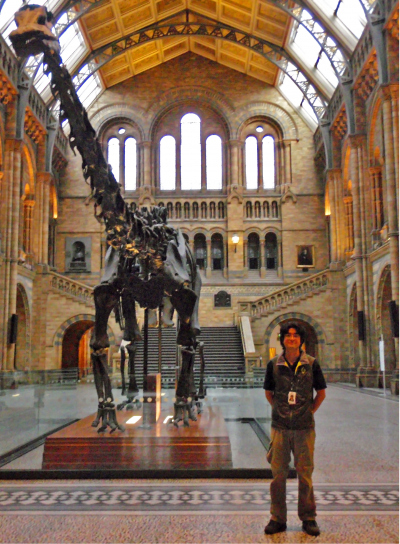Page path:
- Graduate School GLOMAR
- PhD student reports
- Research Placements
- Kei Matsuyama
Kei Matsuyama
Report of GLOMAR PhD student Kei Matsuyama about his research stay at the Natural History Museum, London, United Kingdom from 13 – 25 October 2014
I am very thankful for the support by GLOMAR which enabled me to undertake a two-week research stay at the Department of Life Sciences of the Natural History Museum (NHM) in London. My host was Ms Mary Spencer Jones, senior curator of the Bryozoa section. Main focus was to investigate the bryozoan collection of the Challenger expedition (1872–1876), which is said to be one of the foundations of oceanography. During this global expedition, 332 bryozoan species were described, 193 of which new to science. Matching the focus of my PhD project, I concentrated on those from the Cape Verde Islands. Additionally, some syntypes from a bryozoan collection made in 1904 from the Cape Verde Islands was investigated. I have also been able to examine various specimens from the large West African collection, including type material.
After selecting and preparing the specimen for Scanning Electron Microscopy (SEM), we re-imaged them, which is important as for most of them only drawings made with optical microscopes exist. As expected, most of them require a re-description and taxonomic re-assignments. During three SEM-sessions I also increased my skills in operating a low-vacuum SEM and learned new techniques in imaging uncoated material. The staff and users of the Imaging and Analysis Centre at the NHM are very experienced, as they were one of the first to employ imaging methods for such uncoated material.
During my stay at the NHM I was also able to meet Dr Paul D Taylor, one of the leading bryozoan experts and Dr Consuelo Sendino, curator of fossil invertebrates. I have also met Andrea Waeschenbach, working on parasites and the molecular phylogeny of bryozoans and Dr Kevin J Tilbrook, who is an expert of Indo-pacific bryozoans. The many lively discussions of my project and current developments in this field of research were very valuable for me and were also a great pleasure.
In the course of this stay I further took the opportunity to gain insights into the curation and conservation of historical and modern bryozoan material, both fossil and recent, covering dry material, various kinds of slides and also wet specimens.
To conclude, the research stay at the NHM was very successful, as I was able to obtain additional data in support of my project, while I did also learn much about the curation of large collections and new imaging techniques. But most of all, I profited from discussions with experienced bryozoologists. Finally I want to thank Ms Mary Spencer Jones for her hospitality which made my stay a very pleasant one and GLOMAR for giving me this opportunity.
After selecting and preparing the specimen for Scanning Electron Microscopy (SEM), we re-imaged them, which is important as for most of them only drawings made with optical microscopes exist. As expected, most of them require a re-description and taxonomic re-assignments. During three SEM-sessions I also increased my skills in operating a low-vacuum SEM and learned new techniques in imaging uncoated material. The staff and users of the Imaging and Analysis Centre at the NHM are very experienced, as they were one of the first to employ imaging methods for such uncoated material.
During my stay at the NHM I was also able to meet Dr Paul D Taylor, one of the leading bryozoan experts and Dr Consuelo Sendino, curator of fossil invertebrates. I have also met Andrea Waeschenbach, working on parasites and the molecular phylogeny of bryozoans and Dr Kevin J Tilbrook, who is an expert of Indo-pacific bryozoans. The many lively discussions of my project and current developments in this field of research were very valuable for me and were also a great pleasure.
In the course of this stay I further took the opportunity to gain insights into the curation and conservation of historical and modern bryozoan material, both fossil and recent, covering dry material, various kinds of slides and also wet specimens.
To conclude, the research stay at the NHM was very successful, as I was able to obtain additional data in support of my project, while I did also learn much about the curation of large collections and new imaging techniques. But most of all, I profited from discussions with experienced bryozoologists. Finally I want to thank Ms Mary Spencer Jones for her hospitality which made my stay a very pleasant one and GLOMAR for giving me this opportunity.



